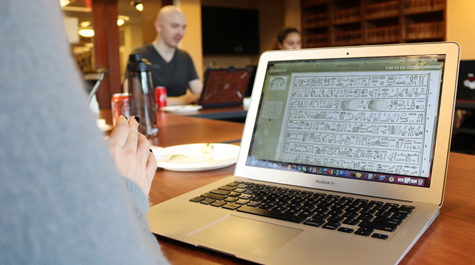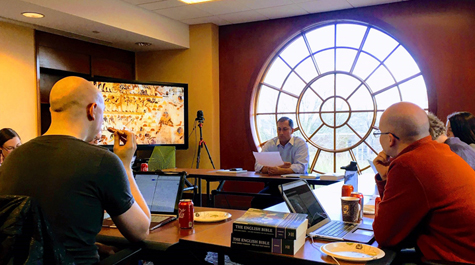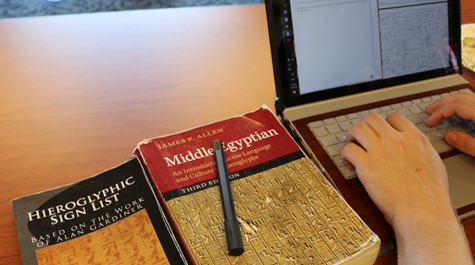https://www.wm.edu/news/stories/2020/wm-professor-creates-unique-opportunity-for-students-to-learn-egyptian-hieroglyphs.php
W&M professor creates unique opportunity for students to learn Egyptian hieroglyphs
Jeremy Pope and seven eager students sat at tables in Swem Library's Brown Board Room on a Friday afternoon in February and munched on pizza, drank soda and discussed a passage most people couldn't begin to read.
The passage was made up of hieroglyphic symbols arranged in neat lines. Some of the symbols, called lapwing birds, resembled geese or similar fowl, while others depicted fatigued men on their knees sinking into the ground. Others resembled nothing recognizable to the average, modern eye.
The students were there voluntarily. Their academic commitment to Egyptian hieroglyphs ended last semester, but they loved reading and translating the texts so much that they urged Pope, their professor, to work with them on establishing a new club.
"I just couldn't imagine having one more semester at William & Mary and not translating hieroglyphs together," said Molly McCue '20.
After working out the details, one of the students, Madelyn Little '20, came up with the club's name: The Egyptological Society of William & Mary.
"It was sort of deliciously scholarly," Pope quipped.
The club members spent the first part of this semester meeting at Swem, but with classes moved online due to COVID-19, they have begun meeting remotely via the videoconferencing platform Zoom.
Pope, associate professor of history and faculty affiliate in classical studies, has created a unique opportunity for students to learn the Egyptian language at William & Mary. He began teaching an introductory Deciphering Ancient Egypt course in fall 2018. It was the first in a three-course sequence that also includes Deciphering Ancient Egypt: Part 2 and a seminar titled Middle Egyptian Texts.
The courses have been very popular, and the three-course sequence will be available to W&M students again in fall 2020.
"Ancient Egypt is the best-preserved of the world's most ancient cultures," Pope said. "Consequently, reading ancient Egyptian texts in their original language is like time travel across thousands of years. So it doesn't surprise me that the subject tends to generate so much excitement."
The first course in 2018 was open to 50 students, and it filled up so quickly there was a waiting list to get in. When that course was over, the number of persons in Virginia who could read hieroglyphs multiplied more than tenfold.
"As far as I know, when I began teaching the introductory Deciphering Ancient Egypt course at William & Mary in fall 2018, there were only three people in Virginia who could fully read Egyptian hieroglyphs, and all were professors," Pope said. "At the end of that semester, there were 53 – and 50 of those were undergraduate students at William & Mary."
Students who are interested in taking the introductory course in fall 2020 will find it cross-listed under anthropology (ANTH 343), classical studies (CLCV 209), history (HIST 278), and religious studies (RELG 278), with 50 seats available.
Taking the introductory course does not obligate students to enroll in the sequel courses over the next two semesters, but a large number of seats in the introductory course will be held specifically for rising sophomores, rising juniors and incoming freshmen in order to maximize that opportunity for as many students as possible.
Pope says there are fewer than a dozen universities in the United States where students can learn the Egyptian language, and the others are all Research I universities like the Ivy League schools.
Of the first 50 students to take the intro course last fall, 30 moved on to the next course and then 10 took the seminar in the third semester. Pope gave those 10 students a hieroglyphic text every few weeks — he calls them "Mystery Texts" — without telling them anything about its content or time period. The students collaborated with each other outside of class to translate the text together and reconstruct its historical context as if they had discovered it themselves during an excavation.
During class, Pope and the students would translate and discuss each text together. Unlike other languages that require more straightforward translations, Egyptian translations are open for interpretation.
"The meanings of the words are not always obvious because it's a dead language," Pope said. "It's a language that has hardly been spoken by anyone for thousands of years. And so that always adds an extra layer of complication, but we're also lacking cultural context."
After that seminar ended, the students approached Pope about continuing the work as a club.
"We're all hooked on hieroglyphs," said Riley Aiken '20. "It kind of feels like a miracle being able to parse out the thoughts of people from thousands of years ago.
"I think often people think of Egypt with this gilded separation, like it's a mysterious culture that we'll never really understand beyond mummies and pictures carved on walls. But it's not true. Their language is beautifully grammatically complex, and with it they recorded cultural stories, reflections of life and death, linguistic puns, shopping lists, graffiti, histories and medical texts. With every glyph there's life."
The students formed strong friendships. They have a group text chat where they share jokes and memes about Egyptology.
"It's so ridiculously nerdy, but I love that we have our own jokes," McCue said.
Pope's enthusiasm for Egyptology is now something shared by others on the William & Mary campus.
"When I first learned to read Egyptian, these texts proved to be infinitely more fascinating than I had ever expected, so sharing this language with students at William & Mary and watching them come to a similar realization gives me real joy," Pope said.
The rapport the students have is a large part of the fun. Pope's selections of texts make for some entertaining and interesting conversations.
In one recent meeting, the students translated a text called the "Excommunication Stela," in which a king expels a group of priests who had confessed to conspiring "to kill a man who had committed no crime," and then the king punished the priests by setting them all on fire.
"This ancient inscription has received very little attention from scholars so far," Pope said. "It raises a number of questions: Whom did the priests conspire to kill and why? Did they actually murder him? We don't even know the identity of the king who punished them, because his name has been carefully erased from the stone. Who erased his name, when and why? There are excellent clues to these mysteries in the metaphors and euphemisms that are used in the text, so it is just waiting for students to perform some careful detective work on it."
When they met, the students took turns reading the mystery text and gave their insights into the translation and context of each line. Pope gave affirmations as each student made a discovery, and he added his own expertise when the occasion called for it.
"A lot of it is connecting with the ancient world and not just learning about it but learning what people thought about their own situations and about themselves and about what they're doing, which I think is really interesting from a personal perspective but also from a more academic perspective," said Kendall Kin '20.
"A couple of semesters ago, we were looking at some graffiti that had been done on the pyramids or on the inside of the pyramids. Humans are silly. Humans haven't really changed at all over the past 2,000 years, which is very interesting."
Pope is an expert. He is one of three Egyptologists employed at universities in Virginia, but he is the only one who offers courses on the language.
He has done extensive work in the field. He has excavated at Karnak Temple in Egypt, but also much farther south in Sudan, where he is currently an epigraphic consultant for an archaeological project at the ancient site of Jebel Barkal, the location of several temples and pyramids.
The Egyptological Society of William & Mary is an intellectually diverse group. Aiken will be doing post-graduate work in dentistry next year, while another is headed to law school and another has landed a job in finance.
Aiken wrote her term paper last semester on the Ebers Papyrus, a wide-ranging medical treatise that contains one of the earliest discussions of dentistry in world history.
"I translated the whole section on dental care from scratch because my reference books came in so late," Aiken said. "I finally got the reference books, but it turns out I had translated it fine."
Of the 10 students who continued taking Egyptian language across all three semesters, one of them has already been admitted to several Ph.D. programs in Egyptology, while another traveled to Egypt this past summer for a Monroe Summer Research Project, and still another is planning to pursue a career in Phoenician archaeology.
"I know that every time I go to a museum with an Egyptology exhibit that I'll spend inordinate amounts of time in front of those displays trying to read some of the hieroglyphs," Aiken said. "Professor Pope gave me the skills to be able to use the reference books and figure out the grammar.
"I don't think I will be studying Egyptology in any more official courses, but theoretically, though I'm no expert, I can continue translating to my heart's content."
-- Sent from my Linux system.



No comments:
Post a Comment